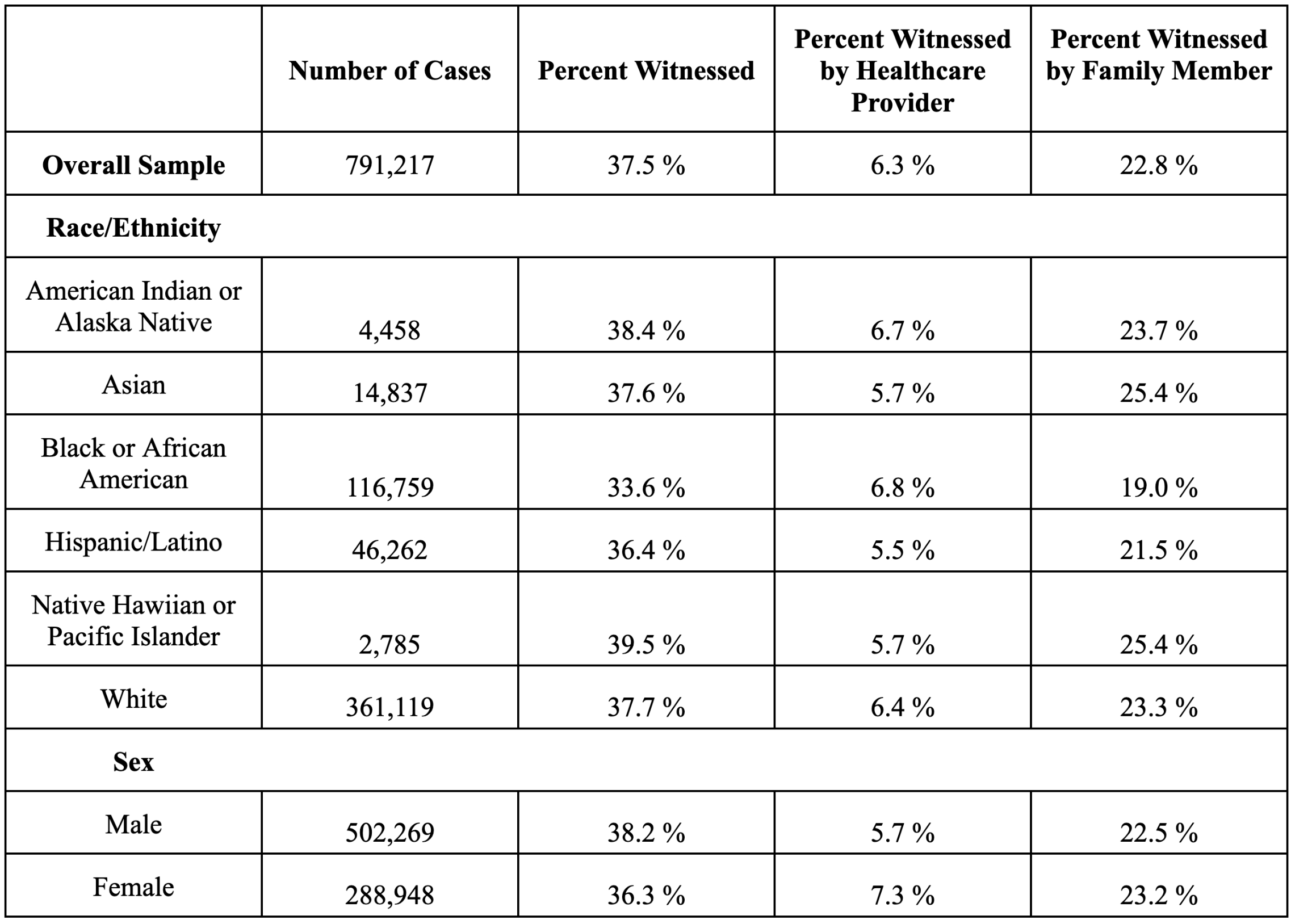Final ID: Su602
Categorizing Witnessed Out-of-Hospital Cardiac Arrest by Bystander Type
Abstract Body: Witnessed out-of-hospital cardiac arrests (OHCA) are associated with improved outcomes with increased likelihood of rapid activation of the emergency response system thus decreasing no-flow or low-flow times. Current literature has largely treated witnessed cardiac arrest as binary (i.e. was a cardiac arrest witnessed Yes/No). We hypothesize there is a need to further delineate and categorize distinct bystander types; these differences may have important downstream contributions to outcomes and survival and targets for improving training and recognition. For example, a bystander who is a healthcare provider with formal training or has experience performing resuscitation may be associated with better outcomes than a non-medical layperson.
We examined a national-level database of emergency medical services (EMS) activations in the United States (NEMSIS). Inclusion criteria were any adult (18+ years) cardiac arrest activation between January 2022 and December 2023. Cardiac arrests taking place after EMS arrival (EMS-witnessed) were excluded. Witnessed status was described as unwitnessed, witnessed by healthcare provider, witnessed by family member, or witnessed by bystander. Across basic demographic variables, we compared overall witnessed rates, family member witnessed rates, and healthcare worker witnessed rates.
A total of 791,217 cardiac arrests met inclusion criteria. Overall, 62.5% of arrests were unwitnessed, 22.8% were witnessed by a family member, and 6.3% were witnessed by a healthcare provider. Across sex, cardiac arrests in male patients were more likely to be witnessed, however, cardiac arrests in female patients were more likely to be witnessed by a family member or healthcare provider (p<0.05). Significant differences in witnessed status were also seen across race/ethnicity. For instance, cardiac arrests in Black/African American patients were less likely to be witnessed by family members and cardiac arrests in Hispanic/Latino patients were less likely to be witnessed by healthcare workers (p<0.05).
Our analysis of a large and nationally-representative database of cardiac arrest suggests differences in rates of witnessed cardiac arrest and – perhaps, more importantly – the existence of different types of bystanders. Moreover, when considering these differences, there is heterogeneity among demographic variables. Future research is needed to understand whether these differences in bystander type may contribute to differences in outcomes.
We examined a national-level database of emergency medical services (EMS) activations in the United States (NEMSIS). Inclusion criteria were any adult (18+ years) cardiac arrest activation between January 2022 and December 2023. Cardiac arrests taking place after EMS arrival (EMS-witnessed) were excluded. Witnessed status was described as unwitnessed, witnessed by healthcare provider, witnessed by family member, or witnessed by bystander. Across basic demographic variables, we compared overall witnessed rates, family member witnessed rates, and healthcare worker witnessed rates.
A total of 791,217 cardiac arrests met inclusion criteria. Overall, 62.5% of arrests were unwitnessed, 22.8% were witnessed by a family member, and 6.3% were witnessed by a healthcare provider. Across sex, cardiac arrests in male patients were more likely to be witnessed, however, cardiac arrests in female patients were more likely to be witnessed by a family member or healthcare provider (p<0.05). Significant differences in witnessed status were also seen across race/ethnicity. For instance, cardiac arrests in Black/African American patients were less likely to be witnessed by family members and cardiac arrests in Hispanic/Latino patients were less likely to be witnessed by healthcare workers (p<0.05).
Our analysis of a large and nationally-representative database of cardiac arrest suggests differences in rates of witnessed cardiac arrest and – perhaps, more importantly – the existence of different types of bystanders. Moreover, when considering these differences, there is heterogeneity among demographic variables. Future research is needed to understand whether these differences in bystander type may contribute to differences in outcomes.
More abstracts on this topic:
Afferent Rapid Response Limb Failure Prior to Non-ICU In-Hospital Cardiac Arrest and Associated In-Hospital Mortality
Shipley Kipp, Shifrin Megan, Snarskis Connor, Weavind Liza
A Porcine Model of Cardiac Arrest Without Pre-Arrest Fluid Loading, Sternal Molding, or EpinephrineParadis Aidan, Paradis Norman, Gaddy David, Moodie Karen, Mader Timothy, Dufresne Alexandre, Couturier Christine, Dufresne Simon, Davis Daniel, Sims Christopher

